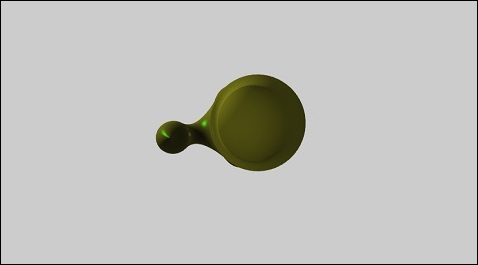BabylonJS - 管状体
管状体是一种弯曲的圆柱形状。它可以根据应用于其以获得坐标的方程式(数学函数)给出不同的参数形状。
语法
以下是创建管状体的语法 −
var tube = BABYLON.Mesh.CreateTube(name, path, radius, tessellation, radiusFunction, cap, scene, updatable?, sideOrientation);
参数
考虑以下参数来创建管状体 −
Name − 为管状体指定的名称。
Path −这是将构建管道的路径。此路径是管道的中心轴。此数组必须至少有两个 Vector3。第一个点是管道的起点,最后一个点是管道的终点。因此,只有两个点,您就会得到一个简单的圆柱体。
Radius − 这是沿管道应用的恒定半径值。仅当参数为 radiusFunction null 时才会考虑此值。
Tessellation − 这与径向段的数量有关。如果将其设置为 3,您将得到一个三角形管道部分;如果将其设置为 4,您将得到一个方形部分,依此类推。因此,请将其设置为您需要的精度级别;段越多,网格越重。
RadiusFunction − 自定义 javascript 函数。构建管道时,将在路径的每个点调用此函数。它将采用 2 个参数,即当前点的位置和此点与起点的距离。该函数将根据计算返回半径。
Cap − BABYLON.Mesh.NO_CAP、BABYLON.Mesh.CAP_START、BABYLON.Mesh.CAP_END、BABYLON.Mesh.CAP_ALL。
Scene − 将显示管道的场景。
Updatable − 默认情况下,此项设置为 false。如果设置为 true,则网格可以更新。
SideOrientation −它采用默认的侧面方向。
带有 radiusFunction 的语法
var myradiusFunction = function(i, distance) {
var radius = 3 * Math.cos(distance / 5);
return radius;
};
var tube = BABYLON.Mesh.CreateTube("tubr", path, null, 20, myFunction, scene);
演示
<!doctype html>
<html>
<head>
<meta charset = "utf-8">
<title>BabylonJs - Basic Element-Creating Scene</title>
<script src = "babylon.js"></script>
<style>
canvas {width: 100%; height: 100%;}
</style>
</head>
<body>
<canvas id = "renderCanvas"></canvas>
<script type = "text/javascript">
var canvas = document.getElementById("renderCanvas");
var engine = new BABYLON.Engine(canvas, true);
var createScene = function() {
var scene = new BABYLON.Scene(engine);
scene.clearColor = new BABYLON.Color3(0.8, 0.8, 0.8);
var camera = new BABYLON.ArcRotateCamera("Camera", 3 *Math.PI / 2, Math.PI / 2, 50, BABYLON.Vector3.Zero(), scene);
camera.attachControl(canvas, false);
// 灯光
var light = new BABYLON.HemisphericLight("hemi", new BABYLON.Vector3(0, 1, 0), scene);
light.groundColor = new BABYLON.Color3(0.2, 0.2, 0.5);
light.intensity = 0.6;
var light2 = new BABYLON.PointLight("light2", new BABYLON.Vector3(-20, 0, -20), scene);
light2.diffuse = BABYLON.Color3.White();
light2.specular = BABYLON.Color3.Green();
light2.intensity = 0.6;
var mat = new BABYLON.StandardMaterial("mat1", scene);
mat.alpha = 1.0;
mat.diffuseColor = new BABYLON.Color3(0.5, 0.5, 0.1);
mat.backFaceCulling = false;
mat.wireframe = false;
var curvePoints = function(l, t) {
// 计算曲线点的数学函数。
var path = [];
var step = l / t;
var a = 5;
for (var i = -l/2; i < l/2; i += step ) {
path.push( new BABYLON.Vector3(5 * Math.sin(i*t / 400), 5 * Math.cos(i*t / 400), 0) );
}
return path;
};
var curve = curvePoints(10, 150);
var radiusFunction = function(i, distance) {
// 计算半径的函数。
var t = i / Math.PI * 2 / 8;
var radius = Math.sin(t) + i / 25;
return radius;
};
var tube = BABYLON.Mesh.CreateTube("tube", curve, 2, 60, radiusFunction, 0, scene, false, BABYLON.Mesh.FRONTSIDE);
tube.material = mat;
return scene;
};
var scene = createScene();
engine.runRenderLoop(function() {
scene.render();
});
</script>
</body>
</html>
输出
上面这行代码生成以下输出 −

 babylonjs_parametric_shapes.html
babylonjs_parametric_shapes.html


